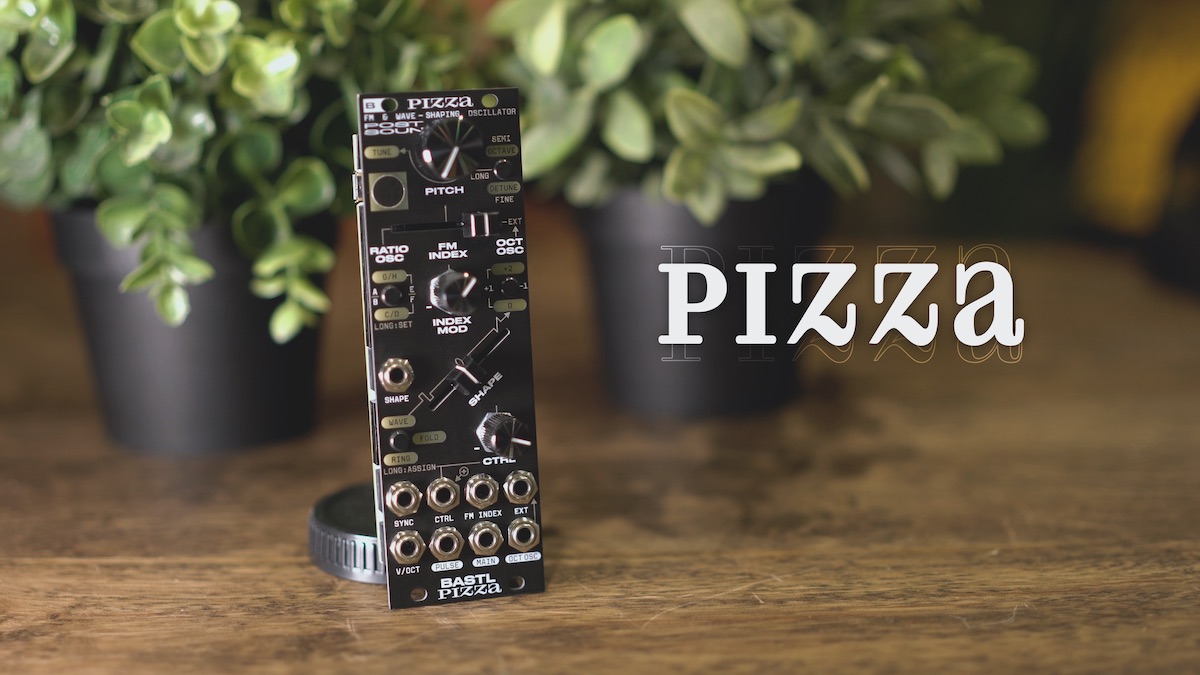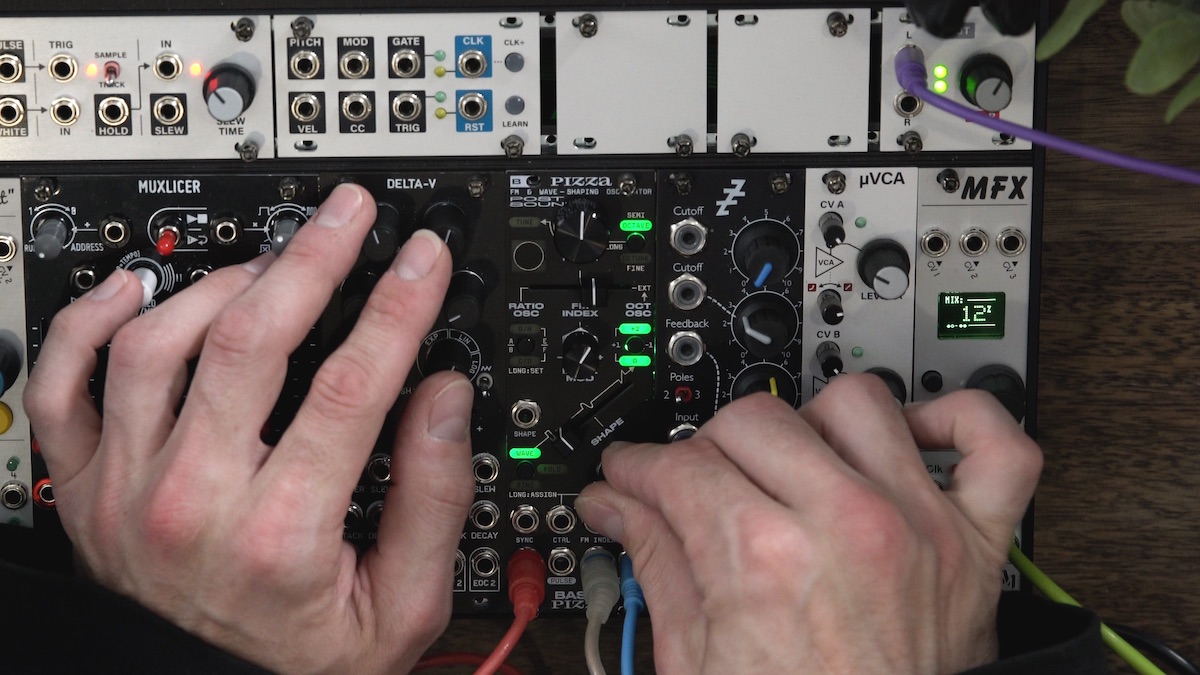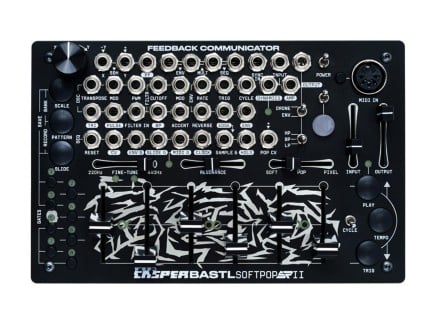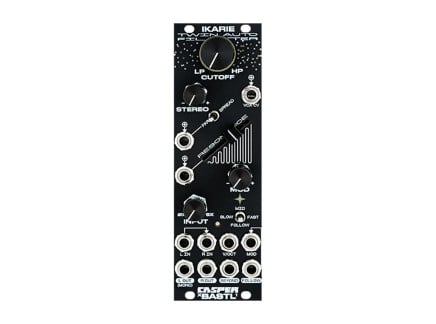By all accounts, there is no shortage of different kinds of oscillators in the contemporary kingdom of Eurorack…simple, complex, digital, analog, single, dual, quadruple…if you can name it, it's probably out there. However, presenting novel ways to make noise never gets old, and a new oscillator announcement from any company is always a reason to get excited. And when this company is Bastl Instruments, the thrill is multiplied manifold.
Those who are familiar with Bastl should know that they never do things quite conventionally. Whether it is a simple utility, a sampler, or an effect, there is always something different, something unique about it. Every release from Bastl is almost a guarantee for a new perspective on sound synthesis. This is undoubtedly the case with their latest offering, Pizza—a digital FM + wave shaping oscillator with a spunky character.
In the video above, Wes demonstrates a variety of flavors that this deceptively compact oscillator is capable of, and this article is aimed to be a companion to the video where we get into more details regarding the inner workings of the device. Without further ado, let's go!
The Origins Of The Recipe
So let's start by discussing what Pizza really is, where it comes from, and what makes it so special (and believe us, it very much is). In essence, Pizza falls into the category of sound generators that in the synthesizer community is now commonly referred to as a complex oscillator—a concept first implemented by Don Buchla in the early days of modular synthesis, first appearing in the modern sense in the early 1970s Music Easel (more specifically, in the Model 208 Stored Program Sound Source module), and later in the now-infamous Model 259 Programmable Complex Waveform Generator. In some ways, this concept can be traced back to the even earlier Model 158 Dual Sine-Sawtooth Generator, and it was expanded on by Buchla considerably in his post-200 Series instruments.
That point aside, modern companies have taken the 208 and 259 oscillators specifically as a point of departure for new designs, such that the idea of a "complex oscillator" has now solidified. By the current-day definition, a complex oscillator usually entails the presence of at least two oscillators—a modulator, and a principal oscillator. The principal oscillator is typically used for generating sound (often with some form of continuous waveshaping capability, usually involving wavefolding), while the other is used to modulate parameters on the principal oscillator itself, such as its frequency or amplitude of the main oscillator. Advanced cross-modulation and feedback patching options are also typically within reach.
Experimentation with this general concept has intensified in the Eurorack format, with designs from The Harvestman (now Industrial Music Electronics), Make Noise, Intellijel, and others appearing over a decade ago. For the most part, each Eurorack manufacturer's vision of the complex oscillator concept is unique in its workflow and sound. Some, like Verbos Electronics's Complex Oscillator aims to be as close as possible to the original, while others like Noise Engineering's Loquelic Iteritas boldly explore novel directions in the design.

If we had to put Bastl's Pizza somewhere on this spectrum, it would lean towards the latter, but also quite a bit beyond. That "beyond" primarily stems from what is evidently another source of inspiration for Pizza: digital FM synthesis, originally developed by the composer John Chowning in the 1960s, and fully embraced culturally in the 1980s with the release of the groundbreaking Yamaha DX7.
It is common for modern instruments to combine multiple synthesis methods together, with much of a particular design's magic stemming from exactly how familiar ideas are combined and used to extend one another. Blending different techniques, methods, and ideas naturally increases the complexity of a device, and how this complexity is managed is what makes a big difference. Time and time again, Bastl has proven that they are experts at designing something that is sonically and functionally complex, while remaining playful and intuitive. So, let's see how they have done this with Pizza.
Three Big Slices, Many Toppings
Pizza is a digital complex oscillator with heaps of possibilities for exploring hybridized synthesis methods ranging from frequency/phase modulation to ring modulation and wavefolding. It doesn't employ a traditional two-VCO architecture, but instead consists of three closely intertwined oscillators: a Main oscillator and two modulators, called Octave and Ratio, respectively.
Both modulation oscillators are internally routed to modulate the frequency of the Main oscillator, though they don't do so simultaneously. The amount of modulation from either Octave or Ratio oscillators is set via the FM Index crossfader. Turn the fader to the right, and the sound is shaped by the Octave oscillator. Turn it to the left, and the Ratio oscillator takes charge of the tone. At the center, no modulation is applied to the Main oscillator. The parameter can also be controlled via control voltage, with the amount of modulation adjusted by the Index Mod attenuverter.
Both modulation oscillators also feature a variable waveshape that interpolates between sawtooth, sine, and square waves. The Octave oscillator allows users to select the desired octave above or below the main oscillator. The Ratio oscillator, in turn, offers a selection of four user-defined musical ratios to be set in relation to the main oscillator's frequency.
But this is not where things end, as the output of the Main oscillator can be further processed through a wavefolder, and then a ring modulator. Moreover, there are two flavors of each. We have here a selection of polynomial or Buchla 259-inspired wavefolders, while ring modulation can be derived from either the Octave or Ratio oscillators.
Pizza features three waveform outputs. The Main waveshaped output is provided alongside a pre-FM Pulse output, and there is a third, dedicated Octave oscillator output. It is also important to mention that the pulse width of the pulse waveform can be adjusted via the multi-purpose Shape slider. Mixing the three outputs together allows for sculpting astoundingly thick, and rich tones. Throw this blend into a filter like the Ikarie, and one can easily spend days simply drifting from one sweet spot to the next.
In terms of modulation inputs, Pizza sports five patch points: FM Index, V/Oct, Ext, Ctrl, and Sync. While the first two are self-explanatory, the other three can benefit from additional details. A signal entering the Sync input resets the phases of all three oscillators. It is a classic hard-sync effect. An Ext input allows us to replace the Octave oscillator with an external signal, therefore facilitating the creation of even more nuanced FM tones. Last but not least, the Ctrl input along with the associated Ctrl knob is like the secret sauce in Pizza—it is assignable to one of fourteen parameters, enabling quick and radical reconfigurations of the oscillator's behavior, and consequently, sound.
You Can't Go Wrong With Pizza
There are many things that make the name of the module so appropriate. Pizza can be viewed as a decidedly multifaceted sound generator that handles a variety of creative sound tasks remarkably well. It can be as mellow or as harsh as you require, and therefore it is difficult to imagine a situation where it wouldn't be useful. Moreover, the organization of controls on the module and a well-thought-out system for navigation between modes make Pizza a very performable module.
The ability to layer and combine various waveshaping processes, and a high level of customization to cater to individual creative needs make Pizza an apt shapeshifter that can seamlessly transform from lead to bass to percussion, sometimes within a scope of a single patch. Therefore it feels apt to conclude with a quote from Henry Rollins: "Pizza makes me think that anything is possible."
















